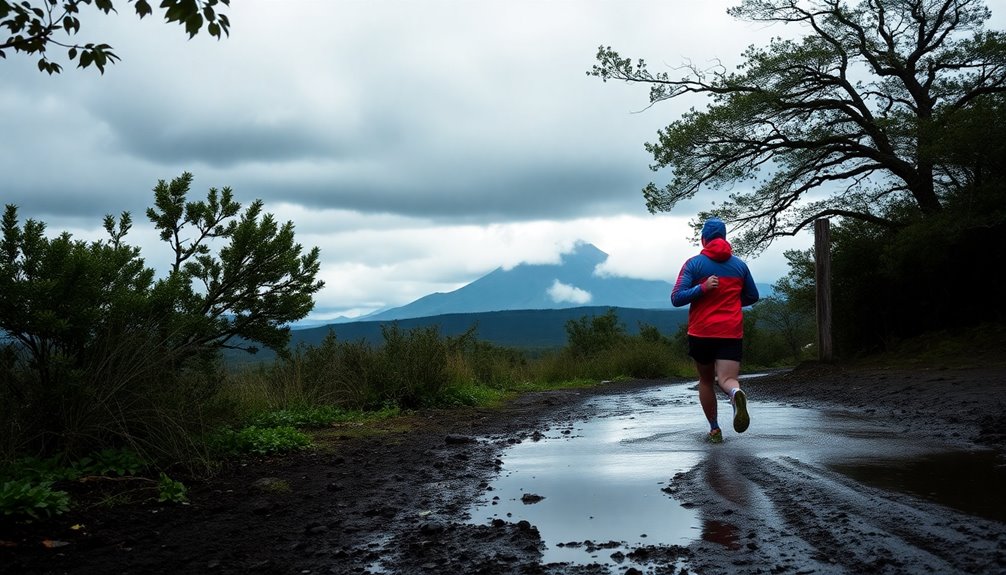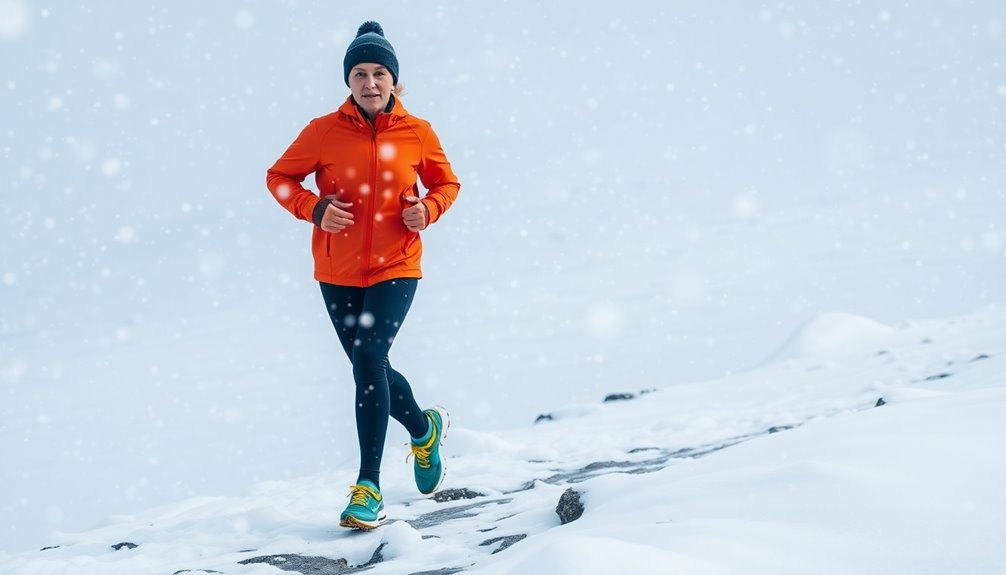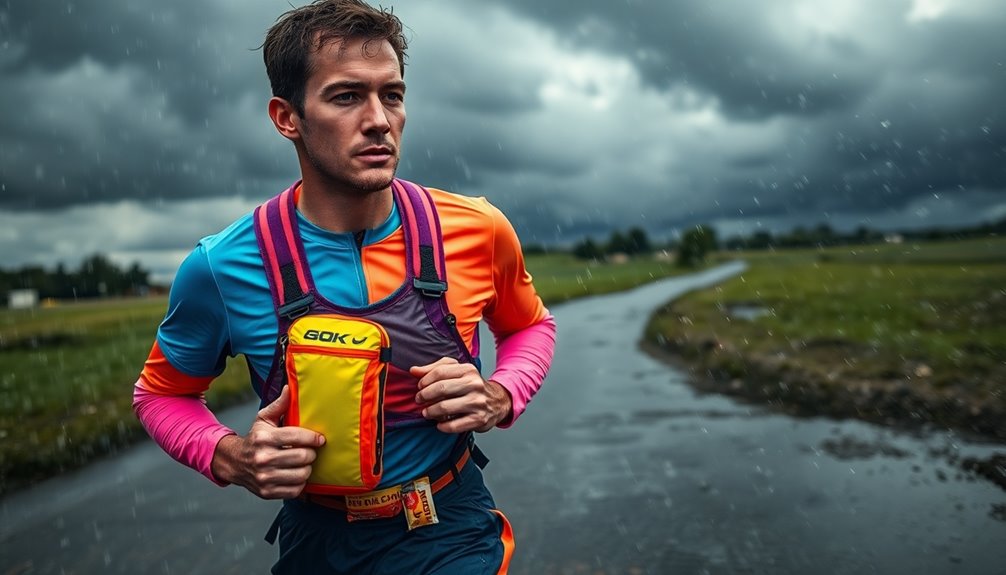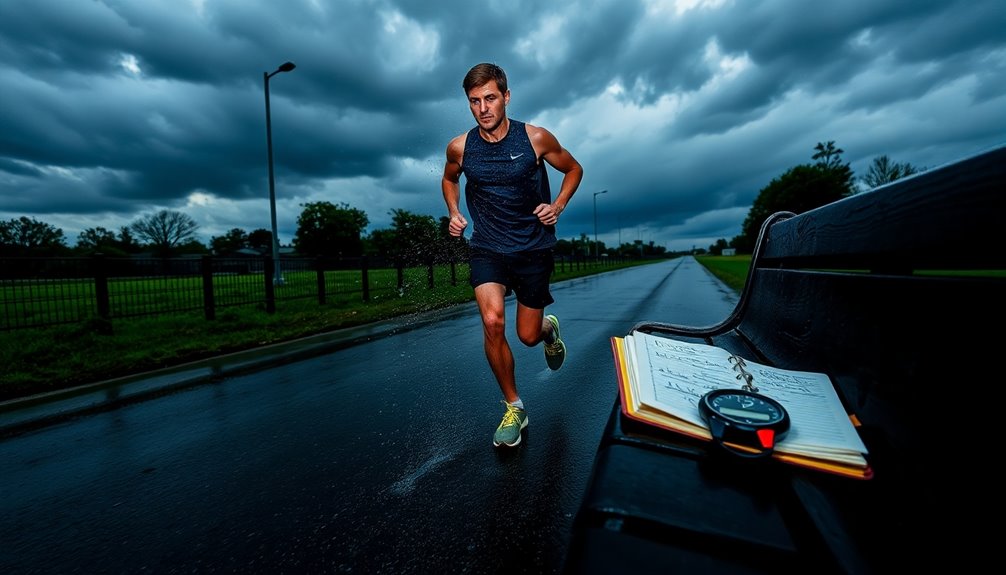When running in challenging weather, you need to gradually acclimatize to new conditions, start light, and increase intensity. Monitor your heart rate and hydration closely. Wear the right gear, like layered clothing, to manage temperature, and adjust your training schedule to avoid extreme weather times. Keep a positive mindset and be adaptable to changes. By considering these factors, you can maintain performance and safety in even the harshest conditions, and there's more to explore about optimizing your training!
Key Takeaways
- Gradually acclimatize to new weather conditions by starting with lighter activities and increasing intensity based on your body's response.
- Monitor hydration levels closely, adjusting strategies based on environmental conditions and sweat loss to maintain performance.
- Layer your clothing appropriately for temperature control, and use waterproof, breathable fabrics to handle unpredictable weather.
- Incorporate mental conditioning techniques such as visualization and positive self-talk to enhance resilience during adverse conditions.
- Adapt your training schedule and routes to avoid extreme weather, and consider indoor alternatives when necessary for safety and comfort.
Understanding Climate Conditions for Running

When you're preparing to run, understanding the local climate conditions is essential, as these factors can greatly impact your training and race day performance.
Pay attention to temperature, humidity, and altitude, as they influence your hydration needs and overall endurance. If you're facing extreme heat, heat acclimation becomes vital; it usually takes 1-2 weeks of gradual exposure to help your body adjust and prevent heat-related illnesses.
Keep an eye on air quality and wind patterns, too, as they can affect your training schedule and safety. Additionally, monitoring air quality indicators can help you determine the best times to train outdoors for optimal health.
Gradual Acclimatization Techniques

To adapt to challenging weather, you'll want to gradually expose yourself to the new conditions. Start with lighter activities and pay close attention to how your body responds as you increase the intensity. This slow approach will help you avoid injuries and better prepare for your upcoming runs. Additionally, incorporating mindfulness practices can enhance your self-awareness and improve your overall running experience.
Gradual Exposure Methods
Acclimatizing to challenging weather conditions is essential for optimizing your running performance, and gradual exposure methods are an effective way to achieve this.
Start by gradually acclimating to heat over 1-2 weeks, which enhances heat acclimation. Begin with shorter training sessions in warmer conditions and slowly extend their duration.
Incorporate specific workouts that mimic the race environment, like warm-weather runs or sauna sessions, to ease the changeover. Adjust your training schedule to match race day conditions, such as running during cooler parts of the day in hot climates.
Don't forget to pay attention to your hydration needs, as proper fluid intake is vital during this acclimatization process for peak performance and safety. Additionally, consider including compound butter recipes in your diet to support your energy levels during training.
Monitor Body Responses
As you work on acclimatizing to challenging weather, monitoring your body responses becomes essential. This process typically takes 1-2 weeks, and being aware of your body's signals can help you adapt effectively.
Here are four key areas to focus on:
- Heart Rate: Keep an eye on your heart rate to gauge your exertion level.
- Hydration Levels: Regularly check your hydration to prevent dehydration and heat stress.
- Sweating Patterns: Notice changes in your sweating; this can indicate how well you're adapting.
- Fatigue Levels: Assess your fatigue regularly to avoid overtraining.
Additionally, staying hydrated is crucial as it helps to support immune system function, especially when facing environmental stressors.
Essential Gear for Different Weather Conditions

When you head out for a run in various weather conditions, having the right gear is essential. Layering helps you control your body temperature, while waterproof and breathable fabrics keep you comfortable in the rain. Don't forget to protect your extremities with the right accessories to guarantee a safe and enjoyable run, no matter the elements. Additionally, using gear designed to improve air quality can enhance your overall running experience, especially in urban environments.
Layering for Temperature Control
Although weather conditions can be unpredictable, layering your clothing effectively is key to staying comfortable while running.
Here's how to master layering for temperature control:
- Moisture-wicking base layer: Start with synthetic materials like polypropylene or polyester to keep sweat away from your skin.
- Insulating middle layer: Choose wool or fleece to retain heat while allowing moisture to escape, essential for maintaining body temperature.
- Windproof outer layer: Protect yourself with a windproof and waterproof layer to guard against harsh elements.
- Accessories: Don't forget thermal hats, gloves, and insulated footwear to protect your extremities from cold.
In hot weather, opt for lightweight, breathable fabrics that wick moisture and reflect sunlight, ensuring you stay cool and comfortable. Additionally, it's important to remember that brewing techniques can also benefit from proper temperature management to ensure optimal flavor extraction.
Waterproof and Breathable Fabrics
Waterproof and breathable fabrics are fundamental for any runner facing unpredictable weather. Materials like Gore-Tex and eVent keep moisture from seeping in while allowing sweat vapor to escape, ensuring comfort during intense runs.
Breathability is important; effective fabrics typically range from 10,000 to 30,000 g/m² in moisture vapor transmission, so you stay dry and cool. Many options come with a Durable Water Repellent (DWR) finish, enhancing performance against rain and snow.
For ideal moisture management, layer these fabrics with moisture-wicking base layers and insulating middle layers. It's essential to test your gear during training sessions to find the right fit and compatibility, as this greatly impacts your comfort and performance in challenging weather conditions. Additionally, investing in advanced filtration systems can further improve your overall running experience by reducing allergens in the environment.
Accessories for Extremities Protection
- Moisture-wicking gloves: Keep your hands dry and warm while maintaining dexterity.
- Thermal socks: Opt for wool for insulation, even when wet, to prevent frostbite.
- Snug-fitting hat or beanie: Minimize heat loss from your head and enhance overall warmth.
- Windproof face mask or scarf: Protect your face and lungs from frigid air.
Additionally, wearing proper gear for your extremities can enhance your performance while promoting eco-friendly practices in your overall running routine.
Hydration and Nutrition Strategies for Varying Climates

When running in various climates, understanding hydration and nutrition strategies is essential for peak performance. You need to adjust your fluid intake based on sweat loss and environmental conditions.
| Climate | Hydration Strategy | Nutrition Focus |
|---|---|---|
| Hot | Preload with 5-7 ml/kg of body weight in fluids | Sodium-rich foods, carbs |
| Tropical | Maintain electrolyte balance with sports drinks | Complex carbs, zinc, magnesium |
| Cold | Stay hydrated with warm beverages like tea | Moderate protein intake |
| Moderate | Monitor sweat rate, adjust fluids accordingly | Balanced diet |
| Variable | Weigh yourself before and after runs | Tailored nutrient intake |
Modifying Training Schedules for Optimal Performance

Adjusting your training schedule is key to maximizing performance across different weather conditions. Here are some strategies to enhance your training runs:
- Warm Climates: Schedule runs early or late to avoid heat stress.
- Cold Climates: Run during the day's warmest hours to stay comfortable and safe.
- Temperature Simulations: Use saunas for heat acclimatization or layer up for cold weather to prepare your body.
- Weather Monitoring: Keep an eye on forecasts and adapt your plans to avoid extreme conditions.
Gradually increase your training intensity and duration over about 10 days to guarantee effective adaptation. Additionally, understanding software development life cycle principles can help you optimize your training planning by ensuring you account for various phases of adaptation.
Mental Conditioning for Adverse Weather Running

Although running in adverse weather can be intimidating, mental conditioning is a powerful tool that can boost your resilience and performance.
Employing visualization techniques can reduce anxiety and sharpen your focus, allowing you to better tackle the elements. Set specific, achievable goals during harsh conditions to cultivate a sense of accomplishment, keeping your motivation high.
Practicing mindfulness and breathing exercises during training enhances mental clarity, helping you manage stress responses effectively.
Developing a "plan B" for inclement weather guarantees you stay consistent, whether it's alternative routes or indoor options.
Finally, engage in positive self-talk and affirmations to strengthen your mental toughness, reinforcing your belief that you can conquer any weather-related challenge. Additionally, maintaining a positive mindset is crucial for overcoming the mental hurdles posed by challenging weather conditions.
Frequently Asked Questions
How to Cope With Running in Hot Weather?
To cope with running in hot weather, you need to stay properly hydrated. Drink 5-7 ml/kg of body weight before your run and keep sipping water every 10-15 minutes while you're out.
Try scheduling your runs during cooler times, like early mornings or evenings, and stick to shaded paths.
Pay attention to your body; if you feel dizzy or nauseous, cool down immediately.
Adjust your race goals based on the heat, too.
How Long Does It Take to Adapt to Running in Heat?
You won't need a time machine to adapt to running in heat, but expect it to take about 1-2 weeks.
By consistently exposing yourself to higher temperatures, your body starts making physiological changes, like improved sweating efficiency and increased plasma volume.
It's all about training smart—whether that means running in warmer conditions or wearing extra layers.
Just remember, everyone's different, so your adaptation might take a bit longer or shorter than others.
How Long Does the Body Take to Adapt to Running?
Your body typically takes about 1-2 weeks to adapt to running, depending on various factors like your fitness level and training intensity.
During this time, you'll notice improvements in performance as your muscles and cardiovascular system adjust.
You might start feeling stronger and more efficient in your runs, especially if you gradually increase your training load.
Embrace the process, and you'll likely experience both physical and mental gains as you adapt.
How to Get Acclimated to Running in the Heat?
To get acclimated to running in the heat, start by gradually increasing your exposure to warmer conditions over 1-2 weeks.
You can wear warmer clothing during your runs or use a sauna to simulate heat.
Make sure you hydrate well before each run, aiming for about 5-7 ml/kg of your body weight.
Pay attention to your body; if you experience heavy sweating or dizziness, take breaks to avoid heat-related issues.
Conclusion
Embracing the elements makes you a running superhero! You're not just braving the wind and rain; you're dancing through storms and conquering heat waves like a champion. With the right gear, hydration, and a fierce mindset, you're unstoppable! So, lace up those shoes and charge into whatever Mother Nature throws your way. After all, running in challenging weather isn't just a test; it's an exhilarating adventure that transforms you into the ultimate weather warrior!









